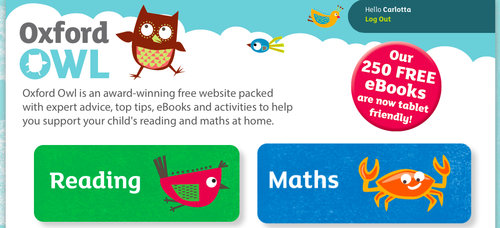Get your kids to love reading with Oxford Owl
A few years ago I discovered Oxford Owl and started using it as part of my teaching material to encourage my younger students to read and, most importantly, to love reading. It was free, with fun graphics and over 250 free eBooks with after reading activities. Oh, and did I mention it’s free?
There was just one major drawback: it didn’t work on tablets, so I couldn’t use my iPad to read books in the classroom nor could I assign reading homework to my technologically advanced students who use tablets. My excitement about Oxford Owl soon faded—at this point you probably know I'm all about technology in my classes.
A few weeks ago, though, I received an email from the Oxford Owl team announcing they are now tablet friendly!
I immediately tried it out and loved it! To make a long story short, all my young students now have their own Oxford Owl account to read as many books as they want (or as I make them ;-).
Why is it soooo good?

1. First of all, the website is free and so are most of the eBooks.
2. You can filter the books by age or reading age of your kid.
3. You can choose between many different types of books (fiction, non-fiction, phonics, traditional stories…) and some of the best series (Oxford Reading Tree, Read with Biff, Chip and Kipper, Read Write Inc Home…).
4. When reading a book, you can choose to mute the reading voice or to pause and play it whenever it’s convenient. If you want your kids to just enjoy a good book, turn the volume up, let the voice read and press the "next" arrow to turn page. Easy peasy lemon squeeze!
How can parents/teachers help children use the Oxford Owl?
Let’s take a very simple book for early readers, Floppy’s Fun Phonics.

1. Let the book read the speech bubble part to you—if it’s the book telling the kids what to do, they are more likely to do it. Then press the pause button before the book reads the caption, as this is the part that your kid is supposed to read by himself (i.e. “Dad is sad”).

2. If your kid is struggling, you can help him by pointing out something in the picture and telling him to find the word for it.
For example, in the picture below, you’ll see a woman holding a sock. Ask the kid what the woman is holding and have him find the word “sock” in one of the two captions.

At this point, he already knows the right answer, but you can push him to read the whole sentence by telling him that now he found the key word, it will be easy to read the rest. Do the same with the other sentence.
Something to keep in mind
1. Reading has to be about fun, not work. Make it a daily routine if you can, but when your kid doesn’t feel like it, read for him. Passive reading is good, too!
2. If he gets stuck on a word or sentence, help him out before he gets annoyed or frustrated. If you read a sentence for him, though, always ask him to repeat it after you.
3. Repetition is key, so it would be great if he could read every book more than once, until his reading is confident and expressive—when children enjoy reading, they become little actors and actresses!
Oxford Owl for schools
If you’re a teacher, you can create an Oxford Owl class account and give out the same username and password to up to 50 students.
Find out more about it here.




